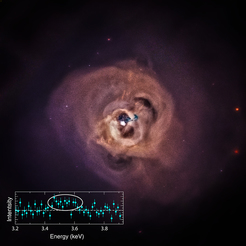Astronomers have known for decades that about 85% of the matter in the Universe is composed of invisible, non-Baryonic particles known as “dark matter”, which can generally only be studied via gravitational interactions on visible matter. While the nature of this exotic substance is still unclear, a number of potential particles have been proposed. One of the more popular candidates is known as the “sterile neutrino”.

A 2014 study of 73 galaxy clusters, including the Perseus cluster (shown in this image), has revealed a mysterious X-ray signal in the data. Using data from NASA's Chandra X-ray Observatory and ESA's XMM-Newton, the stacked spectra of these objects show an excess centered around an energy of 3.57 kiloelectron volts(keV).
This theoretical particle could have a mass of several keV (around 1/100 of the mass of the electron), which would potentially make these particles numerous enough and heavy enough to account for the dark matter in the Universe. Sterile neutrinos are occasionally supposed to spontaneously decay into ordinary neutrinos, a process which produces an X-ray photon with half the mass of the sterile neutrino. The best hope to find this line is to look towards very massive objects (galaxies or clusters of galaxies), which have the highest amounts of dark matter particles.
In February 2014, two independent groups of astronomers announced within a few days of each other that they had tentatively detected an unidentified X-ray emission line that could be interpreted as the spontaneous decay of sterile neutrinos. The first group (Bulbul et al. 2014) studied a sample of 73 galaxy clusters, while the second group (Boyarsky et al. 2014) studied the Perseus galaxy cluster as well as the central portion of the Andromeda galaxy. Both groups measured more photons with energies around 3.5 keV than predicted by their models of intracluster gas emission, and the residual emission profiles look similar to what astronomers would expect to see from an emission line.
The immediate question is whether this anomalous line must be due to sterile neutrinos, or whether it may have an astrophysical explanation. If this line indeed comes from decaying dark matter, it should be observed in other, less massive objects as well – and this is what Mike Anderson and Eugene Churazov at MPA, as well as their collaborator Joel Bregman, set out to test.
Galaxies are much less massive than galaxy clusters, and so their hot gaseous halos are also correspondingly less massive and cooler than in clusters. While galaxy clusters are able to retain enormous halos of hot gas in their gravitational potential which provides the vast majority of the total X-rays, galaxies have almost no diffuse emission at the ~3.5 keV energies corresponding to the location of the new line. The weaker signal from the decaying dark matter in galaxies is therefore balanced by a lower amount of background noise, and galaxies prove to be an excellent complement to galaxy clusters in the study of X-rays from sterile neutrinos. For more information about this study, visit: http://www.mpa-garching.mpg.de/332003/hl201604
